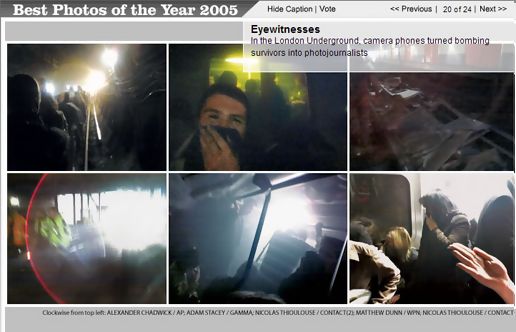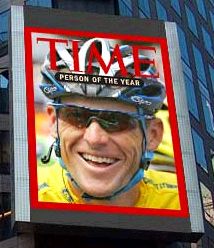
Moblog co-founder Alfie Dennen is furious that the photo agency Gamma has claimed credit for a well-known photo of last summer’s London subway bombing –first circulated on Moblog under a Creative Commons liscence — that was chosen for Time’s annual Best Photo contest. Dennen and others in the blogosphere are hoping that photographer Adam Stacey might take legal action against Gamma for what seems to be a breach of copyright.
We at the Institute are still trying to figure out what to make of this. Like everyone else who has been observing the increasing popularity of the Creative Commons license, we’ve been wondering when and how the license will be tested in court. However, this might not be the best possible test case. On one hand, it seems to be a somewhat imperious “claiming” of a photo widely celebrated for being produced by a citizen journalist who was committed to its free circulation. One the other hand, it seems unclear whether Dennen and/or Stacey are correct in their assertion that the CC license that was used really prohibits Gamma from attaching their name to the photo.
The photo in question, a shot of gasping passengers evacuating the London Underground in the moments after last summer’s bombing (in the image above, it’s the second photo clockwise), was snapped by Stacey using the camera on his cellphone. Time’s nomination of the photo most likely reflects the fact that the photo itself — and Stacey — became something of a media phenomenon in the weeks following the bombing. The image was posted on Moblog about 15 minutes after the bombing, and then widely circulated in both print and online media venues. Stacey subsequently appeared on NPR’s All Things Considered, and the photo was heralded as a signpost that citizen journalism had come into its own.
While writing about the photo’s appearance in Time, Dennen noticed that Time had credited the photo to Adam Stacey/Gamma instead of Adam Stacey/Creative Commons. According to Dennen, Stacey had been contacted by Gamma and had turned down their offer to distribute the photo, so the attribution came as an unpleasant shock. He claims that the license chosen by Stacey clearly indicates that the photo be given Creative Commons attribution. But is this really clear? The photo is attributed to Stacey, but not to Creative Commons: does this create a grey area? The license does allow commercial use of Stacey’s photo, so if Gamma was making a profit off the image, that would be legal as well.
Dennen writes on his weblog that he contacted Gamma for an explanation, arguing that after Stacey told the agency that he wanted to distribute the photo through Creative Commons, they should have understood that they could use it, but not claim it as their own. Gamma responded in an email that, “[we] had access to this pix on the web as well as anyone, therefore we downloaded it and released it under Gamma credit as all agencies did or could have done since there was no special requirement regarding the credit.” They also claimed that in their conversation with Stacey, Creative Commons never came up, and that a “more complete answer” to the reason for the attribution would be available after January 3rd, when the agent who spoke with Stacey returned from Christmas vacation.
Until then, it’s difficult to say whether Gamma’s claim of credit for the photo is accidental or deliberate disregard. Dennen also says that he’s contacting Time to urge them to issue a correction, but he hasn’t gotten a response yet. I’ll follow this story as it develops.


